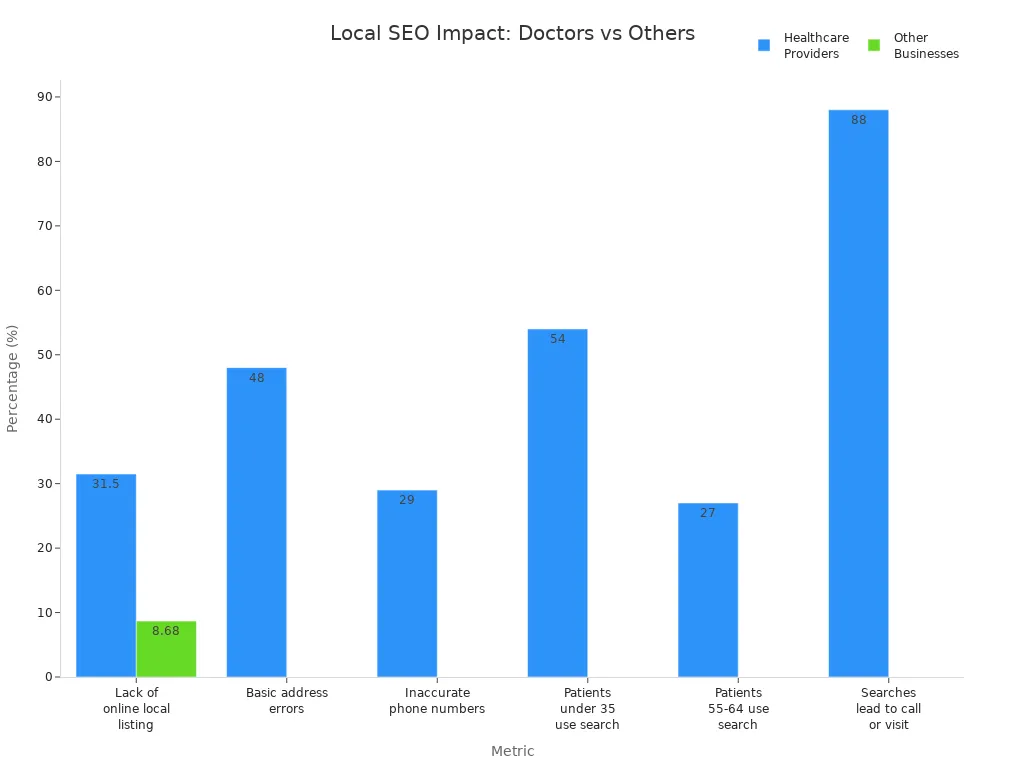Mastering Your Local SEO Plan as a Doctor

Doctors face a unique digital challenge in today's competitive landscape. Over 82% of patients now use search engines to find healthcare providers, making local seo for doctors essential for visibility and practice growth. The healthcare industry experiences higher risks from inaccurate local listings and contact details than most other businesses.
| Statistic Description | Percentage |
|---|---|
| Patients using search engines (Google, Bing, etc.) | 82.8% |
| Patients booking doctor visits through hospital sites | 83% |

Healthcare providers see 88% of localized searches result in a call or visit within 24 hours. Local seo tips for doctors can directly impact patient engagement and appointment rates. A strong Local SEO Plan helps doctors connect with more patients and build trust within the community.
Importance of Local SEO
Patient Acquisition
Local SEO plays a vital role in how patients find healthcare providers in their area. Survey data shows that 69% of U.S. adults use the Internet first to discover new doctors. Only 15% turn to other healthcare providers for recommendations. This trend highlights the importance of local SEO for doctors who want to reach more patients. Many patients now use digital platforms and apps to connect with providers who share their background or understand their needs. These platforms help patients feel more comfortable and confident in their choice.
A strong local SEO strategy increases a practice’s visibility in local search results. When patients search for terms like "doctor near me," practices with optimized profiles appear at the top. This visibility builds trust and makes it easier for patients to contact the practice. Local searches often lead to quick action, with many patients calling or visiting within a day. Doctors who manage their Google Business Profile, keep their information accurate, and collect patient reviews see better results. These steps improve the chances of attracting new patients and growing the practice.
Tip: Keeping your practice’s name, address, and phone number consistent across all platforms helps boost local search rankings and patient trust.
Practice Growth
The benefits of local SEO for doctors extend beyond patient acquisition. Reviews account for about 40% of local search ranking signals on Google. Practices with many positive reviews rank higher and gain more trust from patients. This trust leads to more appointments and steady practice growth. For example, one medical practice saw a 2.5 times increase in search impressions and a threefold rise in organic clicks after starting a monthly SEO strategy.
Local SEO also helps practices stand out in a crowded healthcare market. A fully optimized Google Business Profile places the practice in front of more local patients. Accurate information and positive reviews on this platform make patients more likely to choose the practice. As more patients rely on digital tools to find healthcare, practices that invest in local SEO continue to grow and succeed.
Local SEO for Healthcare

Local vs. General SEO
Local SEO for doctors differs from general SEO in several important ways. Local SEO focuses on helping healthcare providers reach patients in specific geographic areas. Doctors must optimize their Google Business Profiles with accurate details, such as address, phone number, and office hours. They also need to encourage patient reviews and respond to feedback to build trust. Local SEO for healthcare relies on using keywords that include city or neighborhood names, like “pediatrician in Austin.” This approach helps practices appear in local search results and Google’s local 3-Pack.
General SEO targets a broader audience and often aims for national or global visibility. In contrast, local SEO for doctors emphasizes proximity and relevance to the patient’s location. Healthcare providers benefit from listings on medical directories such as Healthgrades and Zocdoc, which are not as important in other industries. Mobile and voice search optimization play a key role because many patients search for doctors on their phones while on the go. Consistency in practice information across all platforms remains vital for both local and general SEO, but it holds greater weight in medical search engine optimization.
Note: Local SEO for healthcare must also comply with strict privacy regulations, such as HIPAA, which do not apply to most other industries.
Unique Needs for Doctors
Doctors face unique challenges in local SEO. They must protect patient privacy and follow HIPAA rules when handling any information online. Secure websites and encrypted forms help safeguard patient data. Healthcare SEO requires content that is accurate, ethical, and written by qualified professionals. Google places medical websites in the YMYL (Your Money or Your Life) category, so it checks these sites more closely for trustworthiness.
Doctors should never use misleading claims or misuse patient data. They need to keep their Google Business Profile complete and up to date, including services, hours, and photos. Accurate and consistent information builds trust with local patients. Doctors also benefit from optimizing listings on healthcare-specific directories, which helps them stand out from other local businesses. Regularly updating content and stating author qualifications further supports credibility and compliance.
- Doctors must:
- Ensure HIPAA compliance in all online activities.
- Use secure hosting and forms.
- Provide clear disclaimers that online content does not replace medical advice.
- Regularly review and update information.
- Avoid misleading claims in local SEO for doctors campaigns.
Local SEO Plan Essentials
A successful local seo plan helps doctors reach more patients and build trust in their communities. The plan should focus on several key local seo factors for doctors, including optimizing the Google Business Profile, maintaining NAP consistency, and managing local listings and directories. These strategies form the foundation of effective local seo for doctors and support long-term practice growth.
Google Business Profile
Doctors benefit greatly from a well-optimized Google Business Profile. This profile acts as the digital front door for the practice. When patients search for healthcare providers, 77% use online search before booking appointments. An optimized profile increases the chances of appearing in the local SEO map pack, which highlights top results for searches like "doctors near me."
Key optimization strategies include:
- Use keyword-rich business names and descriptions that reflect the services offered.
- Ensure all business information is accurate, including address, phone number, and office hours.
- Select the most relevant categories for the practice.
- Add geo-tagged photos and videos to showcase the office and staff.
- Post regular updates using Google Posts to engage patients and improve rankings.
- Monitor GBP Insights to understand how patients find and interact with the practice.
A complete and accurate Google Business Profile allows patients to call, navigate, or message the practice with one click. High-quality photos and detailed service descriptions make the profile more attractive and trustworthy. Managing reviews directly on the profile builds social proof and encourages new patients to book appointments. Regular updates and compliance with healthcare guidelines help maintain visibility and trust.
Tip: Claim and verify the Google Business Profile to appear on Google Maps and control the information patients see.
NAP Consistency
NAP stands for Name, Address, and Phone number. Consistency in these details across all platforms is a critical part of any local seo plan. Search engines trust businesses with matching information, which leads to higher rankings in local search results. Inconsistent NAP data can confuse search engines and patients, causing drops in visibility and damaging the practice’s reputation.
Doctors should:
- Conduct regular audits of business details on major platforms.
- Standardize the formatting of the practice’s name, address, and phone number.
- Claim and manage all business profiles to ensure accuracy.
- Update listings promptly when changes occur.
- Use schema markup on the website to help search engines understand contact details.
Specialized healthcare directories like Healthgrades, Zocdoc, and Vitals rely on accurate NAP data. Data aggregators distribute this information widely, amplifying the impact of consistency. Regular auditing and updating of NAP listings ensure accuracy and build trust with both search engines and patients.
Note: Patients often feel frustrated by outdated or incorrect contact information. Keeping NAP details current improves user experience and supports effective local seo strategies for doctors.
Local Listings
Local listings play a vital role in increasing online visibility for doctors. Google Business Profile stands out as the most effective platform, but other local listings and directories also matter. Accurate and comprehensive information on these platforms boosts local search rankings and patient engagement.
Doctors should focus on:
- Optimizing Google Business Profile with up-to-date information, photos, and posts.
- Ensuring consistency across all local listings, including Yelp, Healthgrades, and Zocdoc.
- Adding high-quality photos, which can lead to more calls, direction requests, and website clicks.
- Managing reviews and responding professionally to build trust and credibility.
A BrightLocal study found that businesses with over 100 photos on their Google Business Profile receive significantly more patient interactions. Features like posts and review management enhance engagement and help practices stand out. Consistency and accuracy across all listings remain crucial for local seo for doctors.
Callout: Local listings and directories serve as important touchpoints for patients searching for healthcare providers. Keeping these profiles updated supports the overall local seo plan and drives more patient inquiries.
Website Optimization for Local SEO
Location Pages
Location-specific pages help medical practices connect with patients searching in their area. Each location page should have a unique URL and at least 500 words of content that highlight services and local details. Doctors can improve local search rankings by using local keywords, such as the city or neighborhood name, in titles, meta descriptions, and headers.
- Include NAPW details (Name, Address, Phone, Website) on every location page.
- Add images of the facility and staff to build trust.
- Provide business hours and patient testimonials.
- Embed Google Maps and directions with local landmarks.
- Write unique content for each location to avoid duplicate content issues.
These steps help search engines and patients find the most relevant information quickly. Optimized location pages increase authority and drive more patient visits.
Schema Markup
Schema markup gives search engines detailed information about a healthcare practice. It helps Google understand the business address, phone number, hours, and patient ratings. LocalBusiness schema makes websites eligible for rich results, such as clickable maps and star ratings, which stand out in search results.
- Review and Rating schema allow patient reviews to appear in search results.
- Rich snippets from schema markup improve click-through rates.
- Regular updates to schema markup keep information accurate and credible.
Proper schema markup ensures patients see the right details, such as directions and appointment options, directly in search results. This builds trust and improves local SEO.
Mobile Experience
Most local searches for doctors happen on mobile devices. A mobile-friendly website loads quickly and looks good on smartphones and tablets. Google uses mobile-first indexing, so mobile optimization directly affects search rankings.
- Responsive design adapts to any screen size.
- Fast-loading pages improve user experience.
- Secure sites (HTTPS) increase patient trust.
- Clear calls to action and simple navigation help patients find information easily.
A strong mobile experience keeps patients engaged and supports higher local search rankings.
Reviews and Reputation

Collecting Reviews
Online reviews play a major role in how patients choose a healthcare provider. Many patients now look at reviews as their first step when searching for a doctor. High review volumes and positive reviews help build trust and make a practice stand out. Doctors who collect more reviews often see better search rankings because search engines notice both the number and quality of reviews.
Doctors can use several strategies to collect reviews from patients:
- Use multiple feedback channels, such as online surveys, patient interviews, and social media.
- Create short, unbiased surveys with open-ended questions to encourage honest answers.
- Promote feedback programs to both staff and patients to increase participation.
- Build a team to manage and respond to reviews, showing patients their opinions matter.
- Keep a strong online presence and engage with review platforms to gather real-time feedback.
Nearly 75% of patients consider online ratings before making a choice. By making it easy for patients to leave reviews, doctors can improve their reputation and attract more new patients.
Tip: A simple request after an appointment or a follow-up email can remind patients to share their experience.
Responding to Feedback
Responding to reviews is just as important as collecting them. Patients trust doctors who reply to both positive and negative feedback. When doctors answer reviews quickly and professionally, they show they care about patient experiences. About 20% of people expect a response within one day, so prompt replies matter.
- 89% of consumers look at how businesses respond to reviews before making a decision.
- Responding to negative reviews can turn unhappy patients into loyal ones, especially if the doctor addresses concerns and offers solutions.
- Search engines use review responses as a ranking signal, so active engagement can boost local SEO.
Positive reviews improve search rankings and increase clicks to the practice website. Doctors who manage their reviews well protect their reputation and build stronger relationships with patients. Regular monitoring and thoughtful responses help maintain trust and encourage more patients to choose the practice.
Local Keyword Research
Finding Local Keywords
Doctors who want to reach more patients in their area must start with strong local keyword research. The right local keywords help connect a practice with people searching for specific services nearby. To find these keywords, doctors should use a mix of broad and long-tail phrases. Long-tail keywords often include the city or neighborhood, such as “family doctor in Dallas.” These phrases attract patients who are ready to book an appointment and show high-intent search behavior.
Several tools make this process easier and more effective:
- Google Keyword Planner gives location-filtered search volume data, perfect for hyper-local research.
- Ahrefs Keywords Explorer and Moz Keyword Explorer offer insights into keyword difficulty and competitor analysis.
- SEMrush and SEOmonitor help track rankings and forecast traffic.
- Google Trends shows how keyword popularity changes over time and across regions.
Doctors should begin with seed keywords related to their specialties, treatments, and conditions. They can then expand their list by analyzing search volume, competition, and relevance. Focusing on high-intent search terms ensures the practice attracts patients who are ready to take action.
Tip: Classify keywords by intent, such as “find,” “evaluate,” or “decide,” to match patient needs at every stage.
Integrating Keywords
After identifying valuable local keywords, doctors must integrate them naturally into their website content. The best strategies include placing keywords in titles, headings, meta descriptions, and body text. Creating location-specific landing pages with detailed contact information helps search engines and patients find the right office. Doctors should also use local schema markup to provide structured data about their practice’s address, phone number, and services.
A strong local SEO plan avoids keyword stuffing. Content should flow naturally and address community-specific health issues. Doctors can improve their visibility by updating their keyword list regularly to reflect new trends and patient needs. High-intent search terms, such as “urgent care near me,” should appear in both website copy and Google Business Profile updates.
Note: Balancing keyword search volume and competition leads to better results. Targeting medium competition keywords often brings more qualified patient inquiries.
Content and Engagement
Localized Content
Doctors who focus on creating content that supports local seo see better engagement from patients in their area. Location-specific content targets local patients and builds website authority. Medical practices can publish blogs such as "Top 10 Skin Clinics in [City]" or guides like "How to Find the Best Cardiologist Near You." These articles attract local search traffic and help establish trust.
- Location-focused blogs answer common questions, such as "What is the cost of a hair transplant in [City]?"
- Healthcare guides position doctors as experts and address patient concerns.
- FAQs in blog posts boost engagement and improve rankings for long-tail keywords.
- Patient testimonials mentioning local neighborhoods build credibility.
- Information about local clinics, events, and resources connects the practice to the community.
A gynecology clinic in Chennai, for example, published a detailed guide on pregnancy care optimized for "Best Gynecologist in Chennai." This approach attracted more local traffic and potential patients. Doctors who address community health issues and share local news engage more people and improve their local search rankings.
Video and Social Media
Video and social media play a key role in local SEO for healthcare providers. Doctors can use Google Posts to share videos and social media links, encouraging user interaction. Regular posts on platforms like Facebook, TikTok, and Instagram increase local audience engagement.
- Video marketing builds patient trust by answering FAQs and addressing concerns.
- Sharing videos on social media increases exposure and attracts new patients.
- Active social media pages encourage brand searches, signaling local relevance to Google.
- Patient reviews on social media and Google Business Profiles improve local SEO rankings.
Doctors who maintain an active online presence connect with their community and boost their visibility in local searches. Social media also provides a platform for sharing health tips, updates, and patient stories, making the practice more approachable and trustworthy.
Backlinks and Citations
Local Backlinks
Local backlinks help doctors improve their search rankings and build trust in their communities. These links come from reputable websites within the same city or region. Search engines see local backlinks as a sign that the practice is a trusted part of the local area. Doctors can earn these links by joining community organizations, partnering with schools, or supporting local events. Guest blogging on respected healthcare sites and sharing expert advice also attract valuable links. Creating educational content, such as guides or infographics, encourages other health websites to link back. Doctors who work with healthcare associations and influencers often see more links from trusted sources. Quality matters more than quantity. A few strong local backlinks from respected sites have a bigger impact than many weak links.
Tip: Doctors should focus on building relationships with local groups and sharing helpful content. This approach brings natural links and boosts local SEO.
Directory Listings
Medical directory listings play a key role in local SEO for healthcare providers. These listings show the practice’s name, address, and phone number on trusted platforms. Consistent and accurate information across all listings helps patients find the right doctor and builds trust with search engines. Doctors should claim their profiles on both general and healthcare-specific directories, such as Healthgrades, Zocdoc, and Vitals. Adding photos, keywords, and regular updates makes these listings more effective. Each doctor and location should have its own listing to improve reputation management. Regular checks ensure that all details stay current and correct.
- Directory listings increase visibility in local search results.
- They help patients find and contact the practice easily.
- Consistency in information prevents confusion and supports higher rankings.
Doctors who manage their directory listings well see better online visibility, more patient trust, and stronger local SEO performance.
Tracking and Improving Local SEO
Performance Metrics
Doctors who want to measure the success of their local SEO efforts need to track specific performance metrics. Using tools like Google Analytics and SEMrush, they can monitor website traffic, keyword rankings, bounce rates, and conversion rates. These tools help identify which strategies attract more patients and which areas need improvement. Regular reporting allows doctors to see trends and adjust their approach for better results.
The following table highlights key performance metrics and their importance:
| Key Performance Metric | Description and Importance |
|---|---|
| Local Search Visibility | Shows how often the practice appears in local search results, helping measure patient reach. |
| Google Business Profile Insights | Tracks profile views and user actions, guiding profile optimization. |
| Patient Reviews on Local Directories | Reflects reputation and impacts local rankings. |
| Organic Search Traffic | Indicates the number of visitors from search engines. |
| Keyword Rankings | Shows the position of targeted keywords in search results. |
| Clickthrough Rate (CTR) | Measures how many users click the listing after seeing it. |
| Bounce Rate and User Engagement | Reveals how visitors interact with the site; high bounce rates may signal issues. |
| Backlink Profile | Assesses the quality and quantity of external links. |
| Page Load Speed | Affects user experience and search rankings. |
| Mobile Usability | Ensures the site works well on mobile devices. |
| Conversion Rate | Tracks the percentage of visitors who book appointments or complete other actions. |
Doctors should also track website traffic, local search rankings, patient reviews, and new patient appointments. Monitoring these metrics helps practices understand the impact of their local SEO strategy.
Ongoing Optimization
Local SEO requires regular updates and adjustments. Doctors should review their Google Business Profile, website content, and directory listings each month. They need to update business hours, add new photos, and respond to patient reviews. By analyzing performance data, doctors can spot trends and fix problems quickly.
A successful local SEO plan adapts to changes in search algorithms and patient behavior. Doctors who stay proactive maintain strong visibility in local search results and continue to attract new patients. Consistent optimization ensures the practice remains competitive and trusted in the community.
Local SEO remains vital for doctors who want to reach more patients and grow their practices. A strong local SEO plan helps healthcare providers appear in local searches and build trust. Doctors should follow each step, track progress, and update their strategies often. For deeper learning, they can explore guides from Google or join online healthcare marketing forums.
FAQ
How often should doctors update their Google Business Profile?
Doctors should review and update their Google Business Profile at least once a month. Regular updates help keep information accurate and improve local search rankings. New photos, posts, and responses to reviews also boost patient trust.
What is the best way to collect patient reviews?
Doctors can ask patients for reviews after appointments. They may send follow-up emails or use feedback forms. Staff can remind patients in person. Consistent requests increase review volume and improve the practice’s online reputation.
Why does NAP consistency matter for local SEO?
Search engines trust businesses with matching name, address, and phone number details across all platforms. NAP consistency helps patients find the right contact information. Inconsistent details can lower search rankings and confuse patients.
Can doctors remove negative reviews from online listings?
Doctors cannot remove negative reviews unless the content violates platform guidelines. They should respond professionally to all feedback. Addressing concerns shows patients that the practice values their opinions and works to improve care.
Do social media profiles affect local SEO for doctors?
Active social media profiles help increase local visibility. Sharing updates, videos, and patient stories signals relevance to search engines. Social engagement can drive more traffic to the practice website and improve local search rankings.
See Also
Essential SEO Writing Tools To Enhance Website Rankings
Effective SEO Content Sharing Strategies For Marketing Growth
How To Use Link Exchanges For Authentic SEO Success

